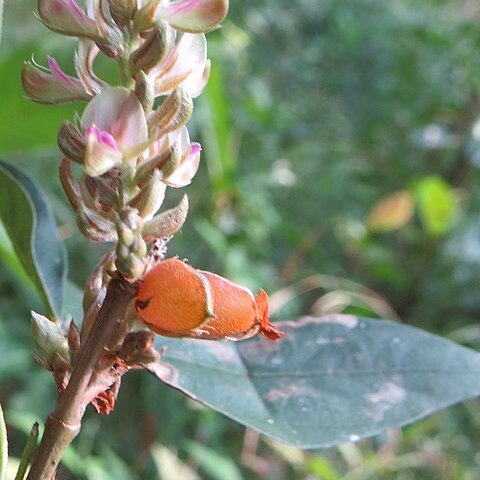Shrubs, erect, 0.8-2.5 m tall. Young branches densely adpressed silky villous. Leaves digitately 3-foliolate; stipules lanceolate, up to 2 cm, villous, with glandular striations, apex long acuminate, usually deciduous; petiole 3-6 cm, narrowly winged; petiolules 2-5 mm, densely hairy; leaflets papery to thinly papery; terminal leaflet broadly lanceolate to elliptic, 8-15 × 4-7 cm, glabrous except for veins, abaxial surface with small dark brown sessile glands, basal veins 3, base broadly cuneate, apex acuminate; lateral leaflets smaller, oblique, base rounded at one side, cuneate on other. Racemes usually clustered at axil, 3-8 cm, with many clustered flowers; peduncle usually extremely short. Calyx campanulate, 6-8 mm, shortly very pale brown villous; lobes linear-lanceolate, ca. 2 × as long as tube, lower one longest. Corolla purple, slightly longer than calyx; standard oblong, shortly clawed, auriculate; wings narrowly elliptic, slenderly clawed, one with auricle; keel oblong, long clawed, apex slightly curved. Ovary elliptic, with very pale brown hairs. Legume elliptic, 10-16 × 7-9 mm, sparsely pubescent, apex with small acute beak. Seeds 1 or 2, glossy black, orbicular. Fl. Jun-Sep, fr. Oct-Dec. 2n = 22.
More
A small shrub or climber. It grows 1.2-3.5 m high. The stems have ridges and are softly hairy. The leaves have 3 leaflets. These are oval or sword shaped and 3-15 cm long by 1.3-8 cm wide. They taper towards the tip and are rounded at the base. There are hairs mainly along the veins. The leaf stalk can be 2-10 cm long. The flowers are about 1 cm long and in dense clusters which are 2.5-7 cm long. The fruit are oblong pods 1.2-1.5 cm long by 7 mm wide. They are softly hairy. They are dotted with glands. The seeds are black and 3 mm wide.
A tropical plant. In Papua New Guinea it is introduced and used as a shelter belt in tea. It grows from 60 m to 1,650 m altitude. In southern China it grows between 200-1,800 m above sea level. In Yunnan.
More
Along watercourses in secondary forest, as well as under drier conditions such as in fields infested with Imperata cylindrica.
Can be grown by cuttings or seedlings. Seeds needs soaking.

